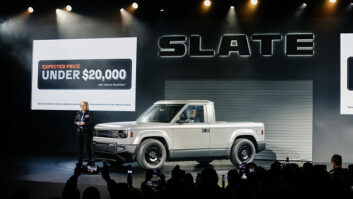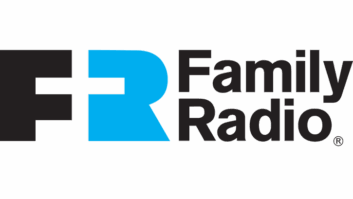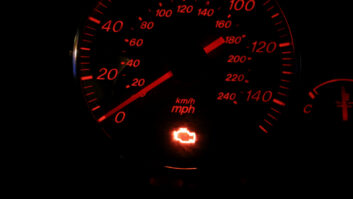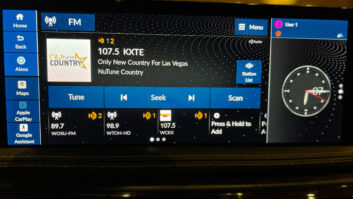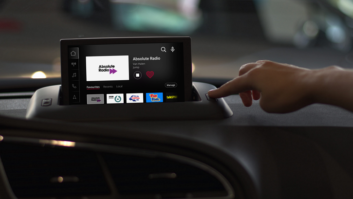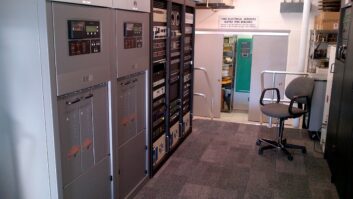
“We’re looking for efficiencies in speed to market,” says Emmis SVP/CTO Paul Brenner of NextRadio’s relationship with iBiquity and their NextRadio/HD Radio auto platform prototype.
Credit:
Photo by Leslie Stimson The companies behind NextRadio and HD Radio say there’s lots of automaker interest in their prototype of a combined platform, one that demonstrates the possibilities of interactive digital radio in connected cars.
The first implementation combines FM analog and digital over-the-air radio services with visual and digital capabilities of the NextRadio smartphone app. It’s a product offering that would help to keep radio relevant, according to Bob Struble, president/CEO of HD Radio developer iBiquity Digital. He believes that soon, “every device that comes with an AM/FM tuner will also have connectivity. Instead of viewing that as a threat, we view that as an opportunity to pair the efficient, free, over-the-air broadcast service with connectivity.”
At the International Consumer Electronics Show, the companies demoed the first iteration of this combined auto platform, essentially the NextRadio “Live Guide” on a car radio. It included images to tell users what was playing on the stations in a given market. Other features of the joint platform are thumbs up/down, social media integration, a “buy” feature and enhanced tuning and discovery.
The result is customized for the car, a version of the NextRadio smartphone app that has been visually simplified to reduce driver distraction while tuning, even in unfamiliar cities, according to NextRadio Marketing Director Michael Cox. Station logos displayed in the dash indicate “that’s hip hop or that’s Rush Limbaugh. That’s who I want to be listening to. That’s my format.”
“By working with the needs of the auto environment, there’s things we can do to make it easier, simpler and safer for consumers,” he said. “The alternative right now is I’m driving at 75 miles an hour and I’m scrolling on my smartphone.”
The prototype stems from work on which iBiquity and NextRadio developer Emmis have been concentrating since they announced an agreement to cooperate last fall. The companies say automakers and their suppliers are interested but declined to identify them yet.
IBiquity brings familiarity with the car tuner user interface, software and hardware to this joint project, while Emmis has expertise with smartphone software and hardware and those interfaces. They worked together to adapt NextRadio’s initial product offering to the vehicle.
IBiquity also brings relationships with automakers and their original equipment manufacturing partners. Struble said the company is accustomed to working with automakers to incorporate HD Radio upgrades, and that this effort is similar. “That’s a much better way to go to market than Emmis knocking on the door and saying, ‘Hey, I’m a new guy. Let me sell you something.’ It will go much, much quicker.”

This display includes models from European suppliers Roberts Radio and View Quest. They manufacture DAB radios and are adding analog/HD Radios to their lineups.
Credit:
Photo by Leslie Stimson Emmis SVP/CTO Paul Brenner agrees: “We’re looking for efficiencies in speed to market.” Brenner also mentioned iBiquity’s relationships with overseas chipmakers, receiver manufacturers, automakers and all of their suppliers. “If I went to market now, I’ve got five years of relationship-building in a lot of countries before I can ever get to the place where they are today.”
The auto platform development is happening at the same time plans are underway for a marketing push to let consumers know about the availability of the NextRadio smartphone app. Cox and Brenner described the audio brand awareness campaign, set to launch Feb. 23, as involving several hundred million dollars’ worth of inventory from stations involved in the NextRadio effort. Audio spots were going into preliminary production in January.
The NextRadio-Sprint deal has been well-publicized. Asked if other carriers are interested, Brenner said: “They are really watching. They want to make sure we’re going to promote ourselves, that we’re going to have enough content on the air so when people activate [the NextRadio app] on their phone, that they’ll get a good experience.”
Promoting the app and getting more consumers to use it “is really the secret to the first half of this year,” Brenner said.
The NextRadio app came preloaded on 34 devices as of mid-February.
70 HD RADIO MODELS
While NextRadio and iBiquity combine work in the car, efforts to increase the number of HD Radio tuners in the marketplace increase.
Some 70 new HD Radio consumer products will be available in 2015, according to iBiquity Digital. Approximately 40 of them will be aftermarket car products.
For example, an expanded Kenwood line includes HD Radio in-dash multimedia, CD and navigation models.
Pioneer’s expanded line features HD Radio in its first CarPlay products, as well as double DIN multimedia and navigation units and CD models. Pioneer introduced the newest HD Radio feature — CAP-compliant EAS. The manufacturer showed units that provide extended text and audio information to supplement broadcast alerts.
New large-display Alpine models feature HD Radio technology, as do double-DIN models from Sony and Clarion.
Grom Audio introduced its first HD Radio auto dongle and firmware. The company’s HDR-1 QRadio dongle adds HD Radio to 30 factory car radio models; the dongle plugs into the Grom-USB3 and Grom BT3 car-integration kits. The kits add stereo Bluetooth, Aux input compressed-file playback via USB input, and iPhone/Android phone USB connection to car radios.
According to iBiquity, every automaker that sells cars in the U.S. now includes HD Radio in at least some models, either as factory standard or optional equipment. Struble calls that the result of a “many, many year effort.”
However, General Motors had announced late last year it was removing the technology from many of its 2015 model-year vehicles. Asked about this, Struble said HD Radio has remained on Cadillacs and big pickup trucks. “The pullback is sort of, ‘Let’s get it right. Let’s do the development we need to do technically and then come back in a broader application.’ We believe that will happen.”
Home audio tuners that include HD Radio are coming this year from Magnum Dynalab and Outlaw Audio. Denon is releasing two “InCommand” AV receivers and Yamaha is releasing “Aventage” line AV units that include HD Radio. McIntosh Labs, too, will release AV receivers that feature HD Radio.

IBiquity is working with its Asian suppliers on a private-label line of HD Radios to be sold online. The pocket-sized SPARC SHD-P360 features FM analog, HD Radio and international tuning.TABLETOPS, PORTABLES?
Fewer devices include over-the-air AM/FM these days. Struble said retail shelf space being devoted to radio products at consumer electronics brick and mortar retailers “is not what it once was.”
As an example, he said, there used to be two aisles devoted to radio products at retailers like Best Buy. “Now, that’s about two feet.”
To combat this trend, iBiquity has added two European suppliers to its receiver partner stable, and plans to launch a private-branded HD Radio receiver line for online sale.
U.K.-based Roberts Radio and View Quest now manufacture DAB radios; they’re adding analog/HD Radios to their lineups. In a year, the industry could see a combination analog/DAB/HD Radio from them, according to iBiquity SVP Marketing and Broadcast Business Joe D’Angelo.
In addition to FM HD Radio, the Roberts Revival RD70HD features FM analog, Bluetooth, 120-hours of battery life and stereo line in. The radio is expected to ship in the U.S. in May.
View Quest says it takes its design inspiration from the arts, interior design and fashion. The company plans to ship five portables, including three featuring Bluetooth wireless connectivity, to the U.S. this year. The models are named Bardot, Hepburn, Christie, Retro and Retro Mini.
IBiquity is working with Asian suppliers for its private label HD Radio receivers called “SPARC Radio.” Struble described them as affordable portable and tabletop products. There were six units on the website: www.sparcradio.com in mid-February; at that time, three were available.
The tabletops include the SPARC SHD-T750, a follow-on to the Narrator AM/FM HD Radio including voice prompts for the visually impaired, the SPARC SHD-BT1, a Bluetooth unit featuring a wood cabinet; and the boombox SPARC SHDTR10.
Three portables appear on the site: the SPARC SHD-TX2, which incorporates emergency alerts; the pocket-sized SPARC SHD-P360; and the SPARC SHD-TR05R, which includes support in English, Spanish, French and Portuguese.
And iBiquity certified Frontier Silicon’s Verona (Model: FS2250) Master Mode HD Radio module and Venus HD Radio Reference Platform for tabletop and home HD Radio receivers. The module is designed for manufacturers that want to make low-cost FM HD Radio products. It is electrically and mechanically compatible with Frontier’s Verona DAB module to allow product migration from existing product designs sold in the European markets, according to Frontier Silicon.
